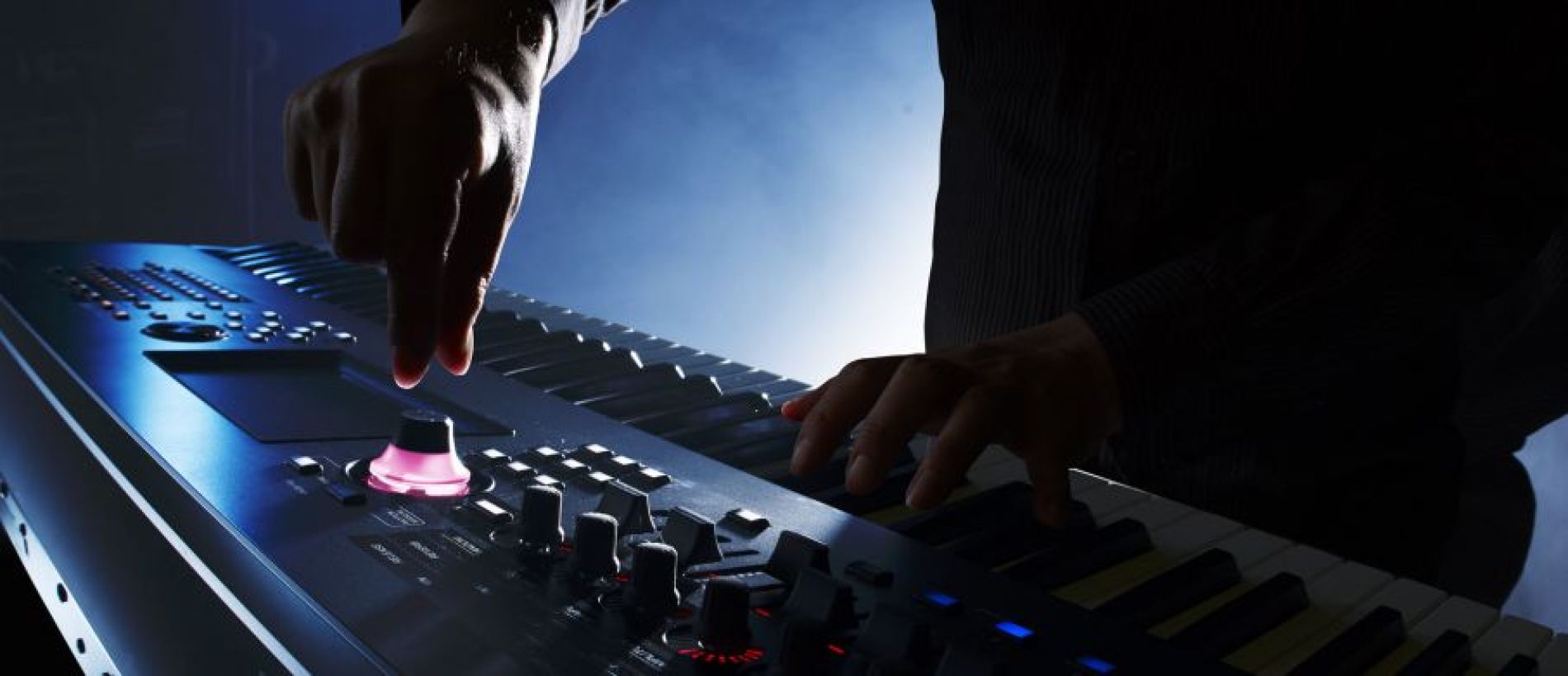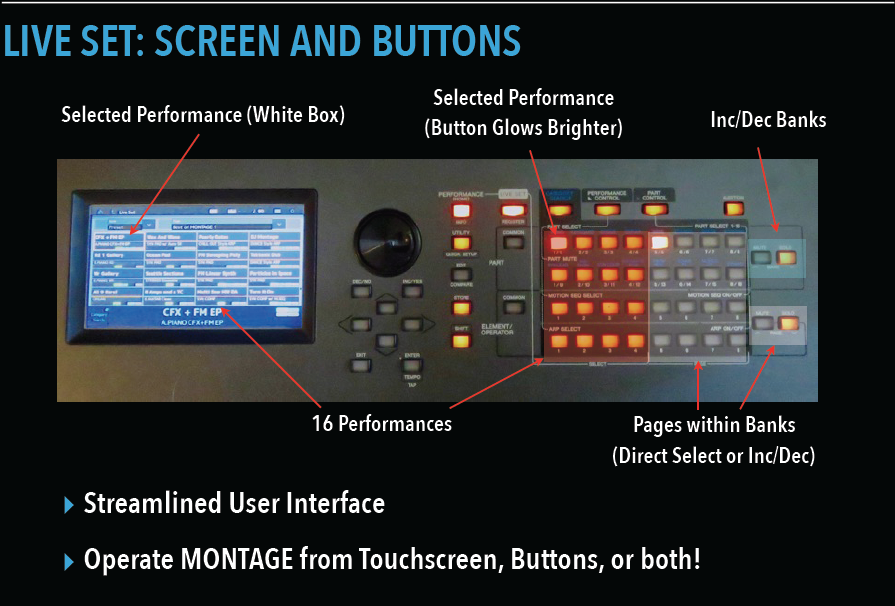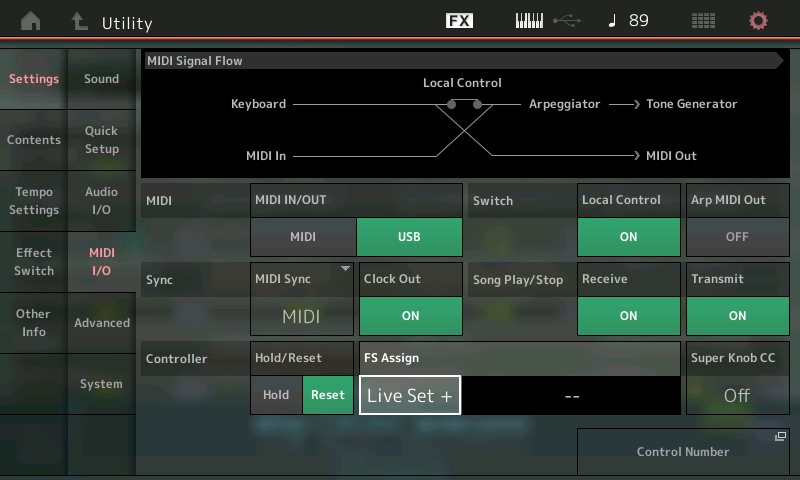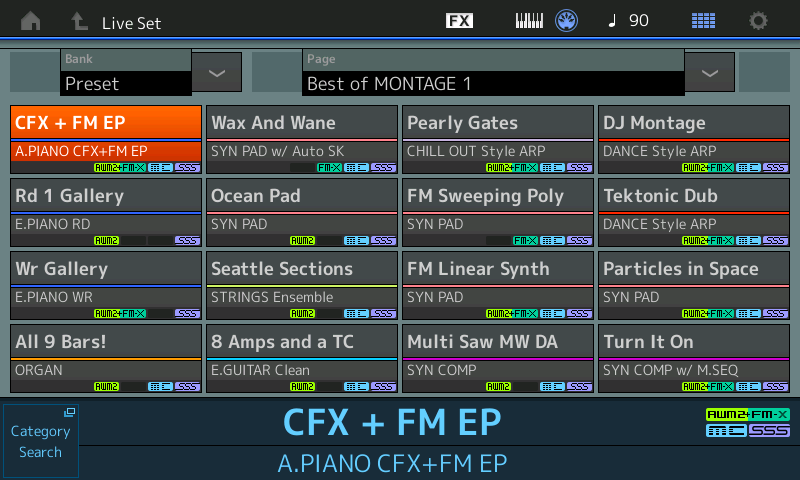With a Yamaha FC5 plugged into the Assignable Foot Switch jack, (FS = Live Set+) a simple press will advance to the next item in your programmed list. You will find this very handy, because you will unlikely want to have access to your full front panel and screen to view your assigned parameters. Activate the [PERFORMANCE CONTROL] which allows you to interact with your currently selected sound, turning the Faders into “drawbars”, or selecting a set of pre-assigned functions for the eight AsgnKnobs for the Part you select to play/feature. You’ll want to have access to the [PART SELECT] function while on stage so you can move like a gazelle between the sounds you need, when you need them.
You may already know that the FS will advance you through these 16 programs with each press. But here’s the “did you know?” moment: start by selecting “CFX + FM EP”, in the upper left corner of the LIVE SET grid; Press [PERFORMANCE (Home)] button to navigate so you are looking at the Performance (Home) screen of “CFX + FM EP”. Step on the FS to advance to “Wax and Wane” > step again to advance to “Pearly Gates” and so on. You do not have to be looking at the “Live Set” grid, the pedal advances you through the most recently accessed Live Set, in the order you listed them. Continue advancing through the list one by one. The pedal will advance you through the currently active LIVE SET list even without the grid screen showing. You don’t need to see the grid unless you’ve forgotten what’s coming next. Returning to the LIVE SET view, by pressing [LIVE SET], resets the list to the top.
The USER LIVE SETS: You have eight BANKs containing USER 1-8. Each of the eight BANKs has 16 PAGES. You can organize your data as you see fit. Each BANK could represent a different band, if you happen to play in multiple situations. LIVE SETS are stored in their own MONTAGE Folder. LIVE SETS can be placed in your Read Only Memory (LIBRARY) for access. LIVE SETs can be recalled from the DATA UTILITY > LIVE SET folder and returned to current USER memory.
Each user will have to figure the most efficient way to utilize and manage your LIVE SETS. If you play in a situation where you are constantly changing and altering your set list order, you may require an external solution. The MONTAGE’s current system does not have an “insert” function where subsequent assignments are pushed back, nor a “delete” function where assignments close rank, therefore, you will need to rely on an external application to assist you in instant realignment of programs. Since MONTAGE Performances are small bulk data packets, such an external application is not impossible, in the future.
Download Examples (see very bottom of the article: “LiveSet Examples.zip”)
Warning: Please make a backup USER file of your work before loading the download example file. The example file will overwrite your internal User memory. If you make a backup you can restore your User setup after learning from the tutorial.
Let’s look at the download examples of some typical “LIVE SETS” _ USER 1, PAGE 1
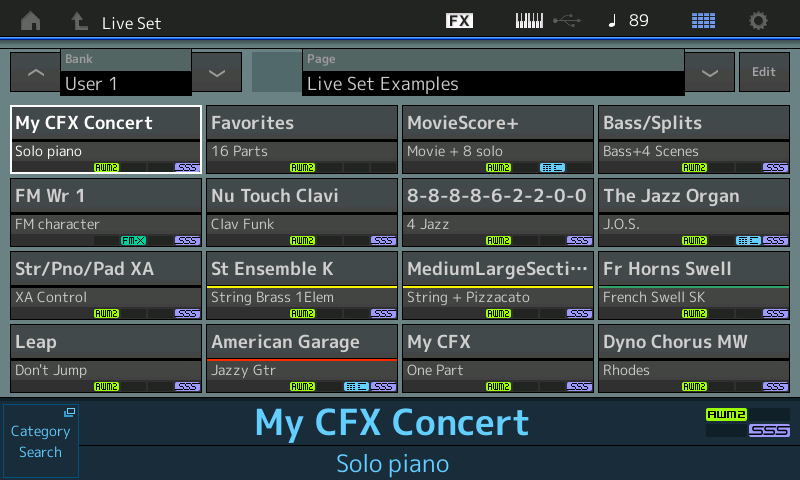
The purpose of these programs is to serve as examples of the different TYPES of Performances and how you might use them on a gig… We will highlight some of the entries and explain their particular use.
“My CFX Concert”
Press [LIVE SET] – select slot 1: “My CFX Concert” and go to its Home screen.
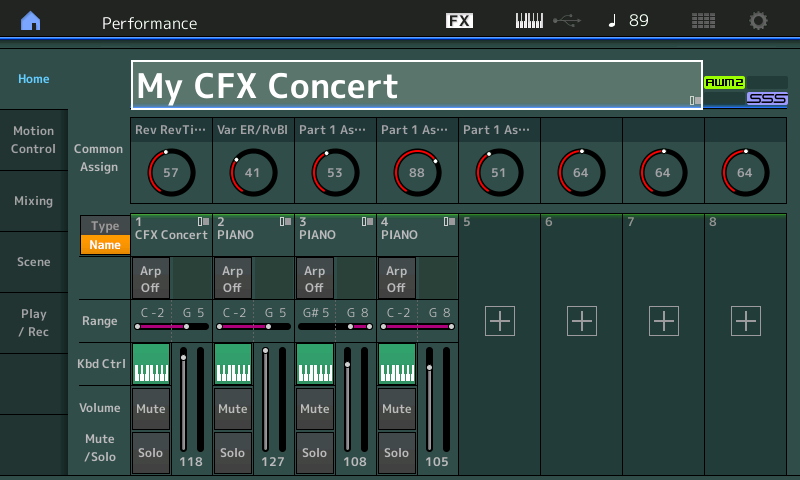
Here we have a multi Part, single instrument Performance. The “CFX Concert” in its full 4-Part, multi Element glory, is here, by itself, for when I need a solo piano, with lots of nuance. I don’t use this piano when I’m in with other instruments, because much of what it does extremely well is in the soft and medium strike ranges. I use this particular program when an acoustic piano sound is used as a solo instrument (a rubato introduction, for example, before the rest of the band comes in). The acoustic piano I use in heavily instrumented compositions is typically a bit brighter and setup to cut through the mix of other instruments. I use this big multi Part acoustic piano for solo use or accompanying a vocalist or in small jazz trio ensembles where (frankly) the nuance can be heard and appreciated. And “Featured”!
“Favorites”
In slot 2 of this LIVE SET is a Performance made up of Single Part programs. It contains my sixteen favorite “go-to” sounds so I can cover a wide variety of standard gigs with just this one PERFORMANCE slot.
Touch slot 2 to recall “Favorites” and then go to its Home screen… Or if you are using the FS for advancing through “Live Set+” simply advance to the Home screen.
My edited version of the Single Part “CFX PopStudioGrand”. This piano is designed to be the Single PART CFX! It is initially selected to play when the PERFORMANCE is recalled (KBD CTRL is active), but I designed this to be played by accessing each of the sixteen PARTs, separately, using the [PART CONTROL] > [PART SELECT] 1-16 buttons.
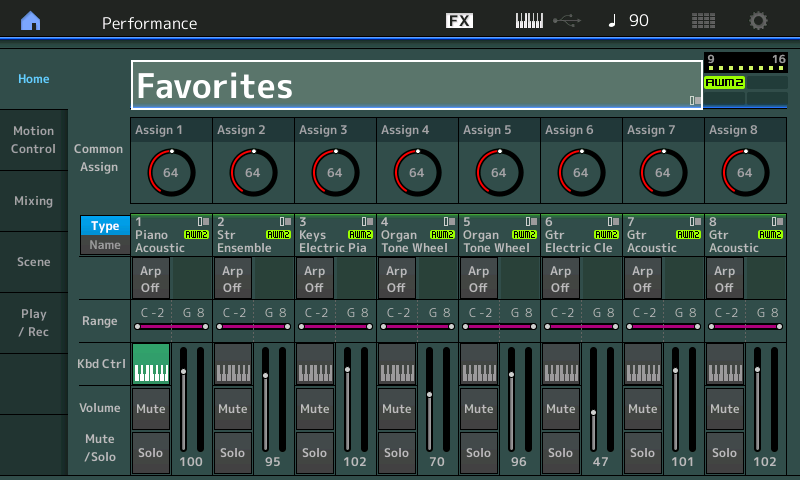
When a PERFORMANCE has active PARTS in the 9-16 area, you will see a icon in the upper right corner of the screen indicating that “9……16” has potentially active PARTS available.
Press [PART CONTROL]
This turns the top two rows of numbered buttons into Part Select [1]-[16] buttons.
Press a PART SELECT button to instantly be in communication with that Part.
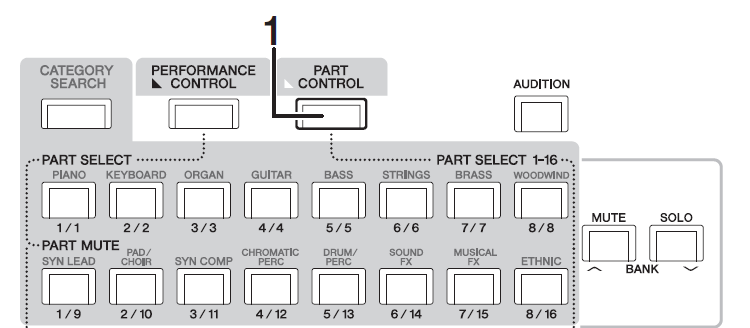
_ Try switching between Parts using these two rows of buttons, while [PART CONTROL] is lit. Notice how this is a glitch-free method to move between your favorite single Part programs. Selecting via the front panel buttons is changing the transmit channels so we are accessing a different individual channel and our controllers switch with us. As you access a Part the controller’s functions switch with you. You can however, hold the sustain pedal on one PART, move to a new PART and play. Or you can hold the keys of one PART, move to a new PART and play using the sustain pedal on the new PART.
_ Try switching the Faders from controlling Part Volume 1-8, or 9-16, to controlling Element/Operator Volume. Once you’ve selected a Part via [PART CONTROL], press the [PERFORMANCE CONTROL] button, the FADERs now work to “perform” and “control” the selected PART – and give you Element/Operator Level control.
[PART CONTROL] each FADER controls a Part Volume 1-8 or 9-16
[PERFORMANCE CONTROL] gives FADERs access to the individual Element/Operator levels 1-8
New with version 1.20.x is the ability to store, on a per Performance basis, whether “Performance Control”, “Part Control”, or “Element/Operator Control” is initially selected. This means you can have the Faders set as “virtual drawbars” when you first recall a B3 sound.
From the HOME screen: touch “Motion Control” > “Overview” > select CONTROL FUNCTION you want initially available, then [STORE] your Performance.
Theory of this ‘LIVE SET’ Use: Here I have assembled a solid “bread and butter” set of sounds with which I could do a standard gig. If ever you have some one come up and sit in, without having to baby-sit them, you could place them in this single Performance and they have everything they need, easily accessible via the [PART SELECT] 1-16 buttons and the 24 quick access plus 8 Assign Knob parameters and the physical controls (MW, PB, RB, FC1/2, AsSw1/2, etc.).
Acoustic piano: I’ve edited the CFX data to suit my needs. I built this from the “CFX PopStudio Grand” a Single Part version of the “CFX Concert”. The multi Part “CFX Concert” makes use of its 18 Element construction with extensive detail on the soft and medium strikes, using this on a hard thumping number where you don’t play anything under a velocity of 100 would be a waste. I tweaked the Single Part CFX to cut through a band. I use the “CFX Concert” for solo piano work.
Strings: These Single Part Strings have a hidden feature: This is based on the “St Ensemble K” which has the orchestrral brass on the Super Knob, and an orchestral bell tone in the upper octaves… All in a single Part, showing the full power of a single Montage component. Notice moving the Super Knob moves only one linked parameter. The “MediumLargeSection” was chosen, again, because of its flexibility: the A.Sw1 changes the articulation from arco (bowed) to pizzacato (plucked).
Electric Piano: Rhodes style, “Dyno Chorus MW”, complete with L/R movement and Phaser. I also included the FM-X Wurli, “FM Wr 1” because of its uniquely playable character.
Jazz organ: two B3s. I lean on the Jazz oriented side, so my “drawbar” B3 has Element 1 sounding the first four 8-8-8-8 full out as a solid jazz foundation, followed by an Element (Fader) each for 2 2/3′, 2′, 1 3/5′, 1 1/3′, 1′, a noise Element and a Percussion Element, gives me strong basis for the Jazz organs I use. The second is straight up a “Jimmy Smith” jazz organ, “The Jazz Organ”, which is just fine with me. James Oscar Smith (Jimmy) for those who may not know, was the founding father of B3 popularity in the world… Legend has it he locked himself in a shed for a year and emerged the beast of the B3.
This one Performance has guitars (acoustic and electric), strings, brass, synth brass, synth lead, a well rounded basic gig set. You, of course, will select your own favorites and begin to make your own collections.
When assembling your sounds into custom Performances, like this, you can begin to customize the AssignKnobs on a per Part basis, linking those Part Assign Knob parameters and/or if you wish, with the Super Knob. When you create a new Performance by merging or adding existing programs, the PART level controller assignments are brought along, automatically, but you must establish new relationships between your newly added PARTs and this Performance’s SuperKnob. A Part, quite naturally, does not bring along its Super Knob relationship when added to a new Performance – the COMMON parameters of this Performance need to be established. But the good news, for each individual Part, 1-16, you can establish a unique relationship with Super Knob control. And you don’t have to guess what an individual Part AssignKnob is controlling because you can give it a custom ‘Display Name’ or you can simply “get” the parameter name. This assignment will appear above the Knob in the screen when you select the Part.
As you get to know your favorite sounds, you can begin to customize exactly which performing parameters you want to have realtime direct AssignKnob access to and which ones should be ganged together on the Super Knob’s movement. Take your time.
Take a look at the tweaks made to PARTs listed here, when you select a PART, for example, you can see what your AssignKnobs are doing. You can customize the knobs so you have access to any parameters you feel you want direct access to when playing this sound.
In this example, each of the sixteen instruments is a Single Part and has an equal weight. A Part plays/sounds only when selected directly. Once selected, the front panel can be used to interact with that sound. Because all Parts are equal, only one of them is activated when you first access this Performance or you press the upper [COMMON] button. Typically, a KBD CTRL icon is lit to designate the sound set to be played when Performance Common is selected. You can use the KBD CTRL icon to quickly layer a couple of sounds, if you desire. Once you are familiar with operations you can quickly create split and layers without leaving the Home screen! Positions of the PARTs can be EXCHANGED using an option of the “Copy” feature. ([SHIFT] + [EDIT])
“MovieScore+”
Return to LIVE SET – select slot 3 “MovieScore” and go to its Home screen or advance using LiveSet+
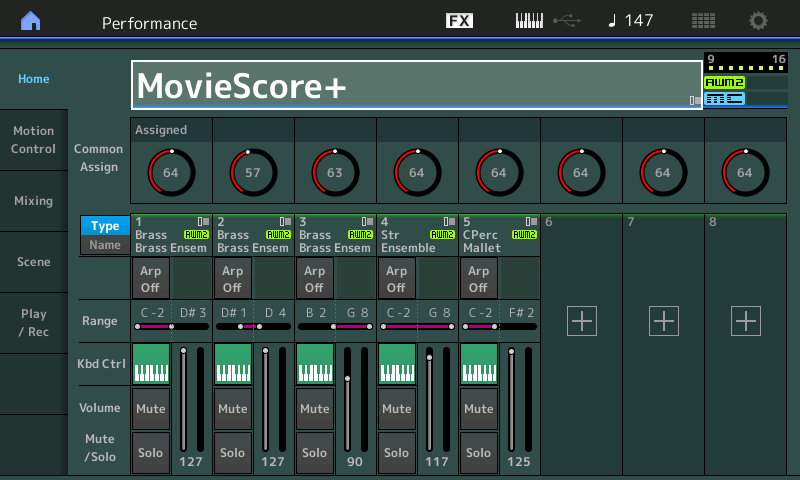
Here we have a MONTAGE “merged” combination built up from an Orchestral Brass Swell, a String Orchestra and a ranged Timpani sound. Dynamic use of the FC7 controlling Super Knob brings your best John Williams themes to dramatic life. Here we are, again, using KBD CTRL to address multiple Parts. If I need this type of thing for a particular theatrical introduction or interlude, I can use Performance slots 6-16 for holding convenient “go-to” Single sounds for what follows. This way I can easily switch between the big theatrical score setup and any individual instrument(s) I require immediately. In Parts 9-16, for individual use, I have “go-to” bread and butter sounds. Again [PART CONTROL] gives me quick access to individual Parts 9-16.
Notes: This Performance was created initially by using the Performance “Merge” function, (+) adding Parts to an existing Multi Part program (“Orch Brass Swell”) to create a new customized instrument, in this case one that morphs strings, brass and dramatic timpani effects based on velocity and Super Knob control. This sort of “merge” programming, covered in depth in Tony “Tones” Escueta’s video spot, is a type of transitioning that is keyboard oriented and extremely musical, from a performing point of view. You can customize the selection of sounds to suit your personal musical needs. This represents a type of musical instrument merging that can be accomplished within Montage.
When a PERFORMANCE has active PARTS in the 9-16 area, you will see an icon in the upper right corner of the screen indicating that Parts “9…….16” have potentially active PARTS available. I’ve elected to add eight Single Part programs to slots 9-16 – sound related to the Movie Score – sounds I need to switch to immediately during this recording session.
When viewing PARTs 9-16 (shown below), you can see the icon in the upper right corner indicates that specifically PARTs 1-5 are occupied back on the first view: Below [PART SELECT 9] has been pressed (cursor highlight indicates this).
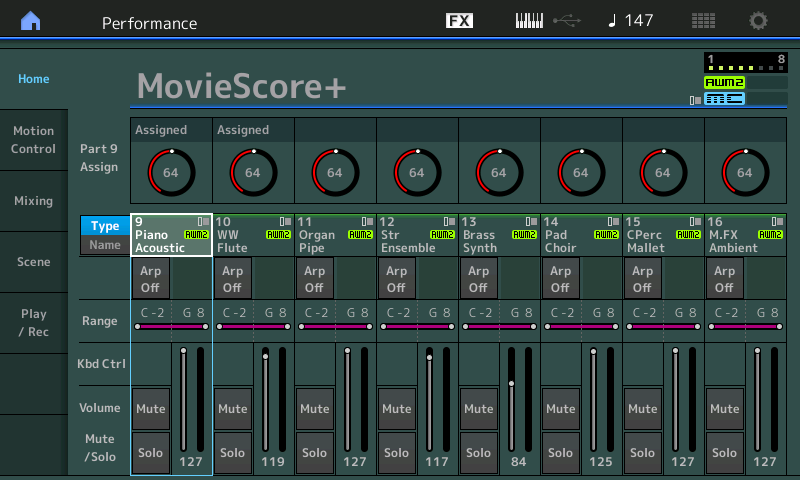
Theory of use: By building this merged multi Part Performance up from the Orchestra Brass Swell Performance, we are using the Super Knob programming (links between the Brass Ensemble Parts and the Super Knob) in the original configuration. We must add links to the Super Knob movement for our newly added Parts, if desired. Remember, when you “merge” a new Part into an existing program, only the “Part” edit assignments are brought along, the upper “Common” level (Super Knob assignement) settings are not brought along. The Common level settings of its new home now apply. The new location for the Part in this new Performance, means a new relationship with the Super Knob (upper level) programming. When you merge a Part into an existing Performance make new associations with the Super Knob on a per Part basis. A maximum of sixteen Source/Destination Control sets exist for the upper level links.
The take away here is that a PERFORMANCE can be combination of a MULTI PART construction (like the MovieScore: String/Brass/Timpani) using Super Knob multiple morphing parameters and individual sounds that can be used in the same composition. One MULTI Performance can occupy a PERFORMANCE, the other slots are always available for whatever individual PARTs you might need to switch to within the context of the current composition. The MULTI PART (KBD CTRL) sounds are interactive and linked such that selecting any one of them selects them all, likewise, selecting [COMMON] selects them all.
“Bass/Split”
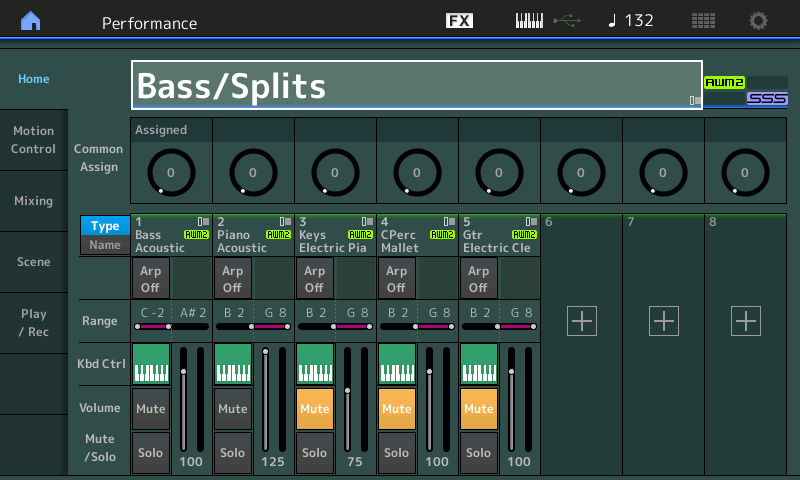
Here a PERFORMANCE is setup with an acoustic bass for (uninterrupted) left hand walking, and uses the SCENE buttons to switch right hand sounds: Acoustic piano, Electric Piano, Vibraphone, and Jazz Guitar. Scenes are instantaneously recallable conditions. Here we are using it to switch right hand sounds. Part 1 is the left hand bass and the right hand sound is changed in each of the blue SCENE buttons. This is a perfect use for Scene buttons because, presumably you are “walking the bass” with your left hand and need to swap the right hand lead sound while maintaining the walking bass… This is not “seamless transitioning”, this is a ‘switch’, the bass remains sounding, while you change to the next right hand sound.
Viewing and editing the stored values in any SCENE can be done by touching “Scene” in the left column of the Home screen. This will drop you into an area where you can view and edit what is assigned to each Scene 1-8
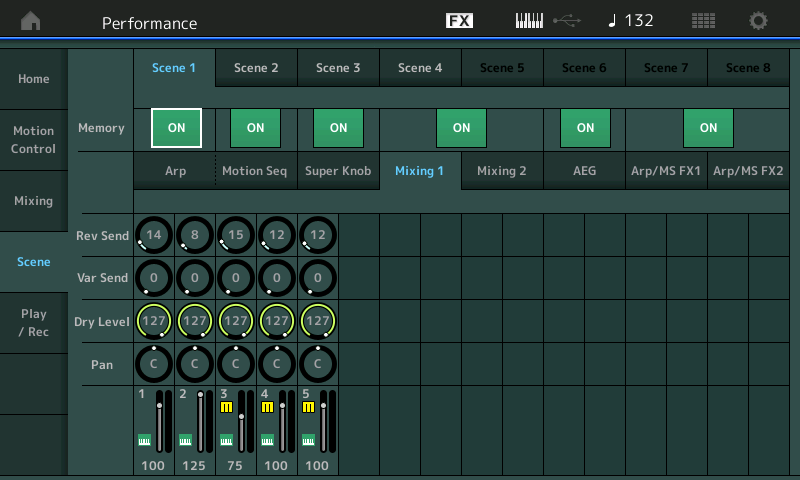
The SCENEs 1-8 are along the top of the screen. Activating a Scene initially is as simple as holding [SHIFT] + [SCENE x] where ‘x’ is a Scene number 1-8 (Blue button). Once active the MEMORY will show ON. Scenes can be used to instantly recall these select parameters.
To better understand SCENE memory switches, think of light or motion pictures. When a scene change takes place in a movie, the directory can elect to morph one into another by fading out and fading in, the director can even overlap scenes do the trees in forest intermingle, momentarily with the skyscrapers of the city scene. Or the director can simply switch from one still frame to a completely different still frame with an entirely different scene. A Scene change in the theatre is accomplished most often with a discernable pause, because all elements might need to change or at least enough things change to warrant a fresh set.
It is only one weapon in the arsenal of recall/automation tools available. It is not sonically seamless, it’s a switch, not a dimmer or crossfader, it’s designed for those types of changes that a switch would work. In music, the more typical use is this method of switching instruments, after all, the sax player actually must put the instrument down before switching to the flute. The smooth overlapping of ‘strings’ into a piano riff, is accomplished in this engine with other functions (morphing, XA Control, SSS, Part Select) that support the continuity of the sounds involved.
Stay tuned for the next article in this series, coming soon!
In the meantime, join us to discuss this article on the Forum here.
